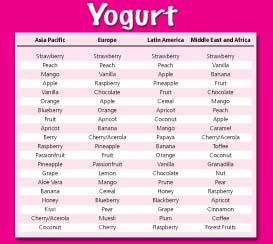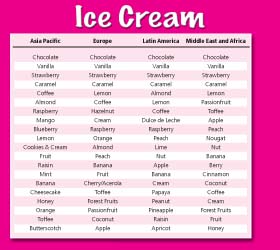
Following global flavor trends enables dairy food and beverage marketers to anticipate future flavor preferences. If you know where your customer is going, or coming from, you can be in the marketplace first with that just-the-right flavor from abroad.
You've heard the U.S. population forecasts. Briefly, in five years, the white population is expected to decrease 1.7 percentage points, and the previous booming segment-blacks-will only increase by 0.4 percentage points. The two groups expected to show the most growth during the next 15 years are Asian and Hispanic. By 2010, the Asian segment is projected to grow 0.8 percentage points, and another 0.8 percentage points by 2020. With Hispanics, the increase is even greater: 2.9 percentage points by 2010 and another 2.3 by 2020. Furthermore, the federal government says that 19% of all children born in 2001 had at least one parent that was foreign born. You can bet that that parent will want to introduce his or her child to the flavors of his or her ancestors.
By being able to preempt the competition with an international flavor, not only do you establish your brand as an innovator among current Americans, but you build a relationship with those ethnic individuals establishing themselves in the United States. Here's an added bonus, many consumers will pay a premium for uniquely or ethnically inspired foods.
Global travel . . . immigration . . . overseas adoptions . . . ethnic ingredients . . . international supermarkets . . . ethnic flavor fusion by influential chefs . . . all of these factors should convince you that the time is right to look to overseas flavor trends and adapt some of them to American dairy foods and beverages. We live in a world marketplace, so go ahead, update some traditional dairy products with new exotic flavors and add an ethnic-inspired recipe to your product line. Look West. Look East. Look South. Heck, even look North to our Canadian neighbors for some inspiration.

Freezer case example
Not sold yet? Here's some inspiration. In just a few years, Ciao Bella, Irvington, N.J., was able to establish itself as the leading artisanal frozen dessert manufacturer in the nation. How? Investing in global flavor inspirations.Ciao Bella is one of the few frozen dessert manufacturers to employ their own chef, Danilo Zecchin, who scours the globe for unique flavors and premium ingredients. Born in Northern Italy, Chef Zecchin draws inspiration from his European heritage as well as from his extensive travels-blood orange juice from Sicily, coconut cream from the Dominican Republic and passionfruit from Ecuador. One particular frozen dessert variety-blackberry cabernet sorbet-is based on a traditional Sicilian dessert served in a classic wine glass, combining fresh blackberries and red wine with a drop of lemon juice and sugar. It is an intense, yet delicate burst of flavor that he remembers his family enjoying on warm summer evenings.
During Spring 2005, Ciao Bella introduced the following ethnic-inspired products: guanabana gelato, peach habanero sorbet, cantaloupe tarragon sorbet, pomegranate sorbet, watermelon sorbet and honeydew melon sorbet. Some of the products are solely found in fine restaurants and other foodservice establishments, whereas some are also sold through select retail venues.
"Everyday brings a different challenge when you're creating new flavors, and fulfilling custom flavor requests from chefs around the country," says Zecchin, who has earned a reputation among the chef community for being able to create even the most exotic and demanding custom flavor requests from restaurants, hotels and caterers. "Once I was asked to create a ‘yuzu sorbet,' and I had never even tasted a yuzu. So I had to track down the fruit, which was out of season, and experiment-not really knowing what the client expected." The good news, according to Zecchin, is that the final version tasted great and was a huge hit at the restaurant.

What the tracking data shows
Some of the uniquely flavored global products showcased in this month's feature story are not trends. Yogurt such as the corn-flavored variety from China's Inner Mongolia Yili Industry Company is not an everyday product. The Chinese are intrigued by it just a little less than we are. And in the Czech Republic, Bohusovicka Mlekarna's prebiotic lemon- and lime-flavored sour cream is by no means the norm for these Eastern Europeans.Mintel's Global New Products Database tracks flavor trends for select food and beverage categories (see accompanying tables). From 2003 until the present, Mintel shows some key regional trends in flavors for ice cream, milk and yogurt.
In ice cream, what's interesting to note is that flavors around the world are just as varied as they are in the United States. And, for the most part, it is too difficult to classify an ice cream as any one flavor, since so many are medleys of different flavors and ingredients.
Flavor trend tracking is a bit easier for the other two categories. With milk, what stands out are the flavors of almond, aloe vera, apple, apricot, caramel, cardamom, carrot, coconut, grapefruit, green tea, honey, melon, papaya, passionfruit and sesame. In the yogurt arena, some noteworthy international flavors are aloe vera, cinnamon, grape, pear, plum and prune.
(Editor's Note: If you want my bet, I predict that aloe vera, green tea and pear will be the up-and-coming flavors for U.S. dairy products by 2010.)
Just remember, when flavoring dairy foods and beverages, there are five major tastes that humans can identify: bitter, salty, sour, sweet and umami (savory). It is the mixture of these that provide the right balance of great taste. And even though one does not think of milk as salty or savory, these flavors are present, though likely very minutely, and do impact the final product.
Working with your flavor supplier is your ticket to success.
